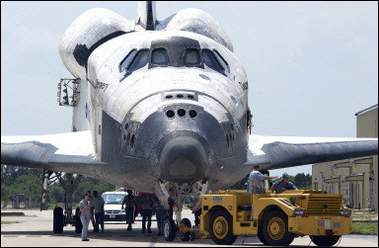|
US space plan in danger
(Washington Post)
Updated: 2005-11-24 16:08 Where he has not fared so well, however, is in allaying lawmakers' misgivings
about the "gap" in human space travel between the end of the shuttle program in
2010 and the first manned flights of the new exploration vehicle in 2014.
Griffin said earlier this year that NASA now projects that the new spaceship
would fly by 2012, with a return to the moon by 2018, but he was unable to
satisfy those who want to close the gap completely.
Sen. Kay Bailey Hutchison, chairman of the science and space subcommittee,
said on Sept. 19 that she "will do everything possible to keep the shuttle and
crew exploration vehicle programs on course," and her words have come to
encapsulate the dilemma now facing NASA.
Under the budgets projected for the next five years, experts outside and
within the Bush administration agree, it will be impossible -- by several
billion dollars -- to complete the planned shuttle missions and finish the new
spacecraft by 2012, or maybe even by 2014.
NASA and the White House budget office said they could not comment on the
shortfall before the official 2007 budget rollout in February, but several
expert sources described ongoing negotiations to find a solution. They spoke on
the condition of anonymity because they did not want to become part of the
public debate or were not authorized to speak for their employers.

The shuttle Discovery.
[AFP/file] | "The budget associated with the Vision's announcement in 2004 [anticipated]
that the shuttle's demands would significantly decrease in 2008 and 2009," said
one longtime NASA watcher. "That was a myth."
Griffin acknowledged as much at a Nov. 3 House Science Committee hearing,
saying the plan to finish the space station and retire the shuttle in 2010 faces
a "$3 billion to $5 billion" funding shortfall.
A committee document placed the deficit at "nearly $6 billion," and some
sources said even that figure could be low. NASA's budget difficulties have also
been complicated by having to pay for about $400 million in special projects
inserted, mostly by senators, into the agency's 2006 funding.
The sources said the White House is juggling several proposals to close the
deficit, but one industry source said, "None of the choices are good -- NASA's
in a box."
But the White House, struggling with the costs of the Iraq war and Hurricane
Katrina, is unlikely to find billions more for space travel. "There's really no
place Griffin can go," said one source familiar with the negotiations. "The
White House gave him the best deal he could expect. He can go back to the well,
but it's not going to happen."
Several sources confirmed that the budget office in the early negotiations
proposed stopping shuttle flights altogether. "It sucks money out of the budget,
and it's a dead-end program," one source said.
But "that argument's over," another source said. "The political side of the
White House said, 'We're keeping it.' If you kill the shuttle right now, it will
be heavy lifting for your foreign policy because of the international
obligations" around the space station.
A proposal under consideration would keep the full complement of shuttle
flights -- 18 to finish the space station and one to service the Hubble Space
Telescope -- and let completion of the crew exploration vehicle slip to 2014, if
necessary, or even beyond.
"The president said originally there would be a four-year gap, and that's
realistic," one source said. "My personal view, though, is whatever date you set
. . . it will slip."
Some negotiators believe they could salvage the 2012 delivery date if NASA
goes to "serial processing," using only one team of engineers to prepare shuttle
flights one at a time. The sources said this would drop the total number of
flights to about 10.
"But what kind of a space station do you get out of that?" one source asked.
"And while you can reduce the workforce and maybe save some money, you don't
know how much, and you're not making anyone happy. This is nobody's first
choice."
The fourth possibility, the one probably favored by Congress, is to fully
fund both the shuttle and the new spacecraft, thus eliminating the entire
four-year gap and ensuring a seamless transition to a new era in human space
travel.
"The message to the White House is to pony up," one congressional source
said. "The green-eyeshade approach undermines the president's legacy. You've got
to have a space station worthy of the name, and you've got to close the
gap."
|